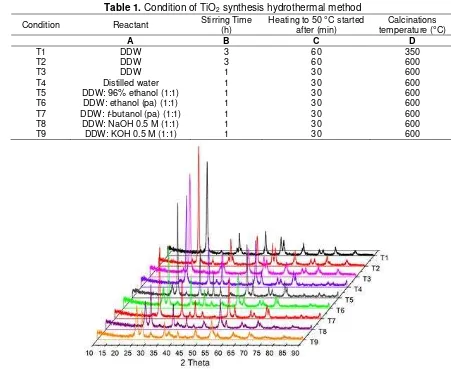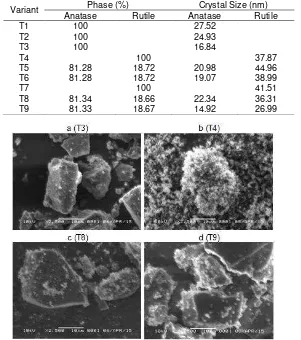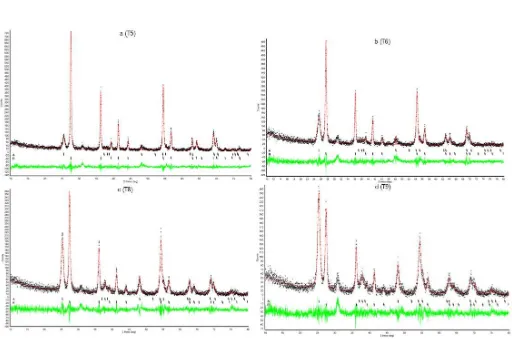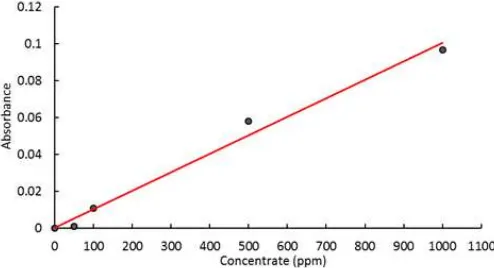Indones. J. Chem., 2017, 17 (1), 22 - 29
Mohammad Rofik Usman et al.
22
* Corresponding author. Tel : +62-8132-2731173
Email address : [email protected] DOI: 10.22146/ijc.23548
Photocatalytic Degradation of Diazinon Using Titanium Oxide
Synthesized by Alkaline Solvent
Mohammad Rofik Usman
1,2, Atiek Rostika Noviyanti
1, and Diana Rakhmawaty Eddy
1,*1Department of Chemistry, Faculty of Mathematics and Natural Sciences, Universitas Padjadjaran,
Jl. Raya Bandung-Sumedang km. 21, Jatinangor, Sumedang, West Java 45363 Indonesia
2Pharmacy Study Programme, Sekolah Tinggi Ilmu Kesehatan,
Jl. Letkol Istiqlah No. 109 Banyuwangi, East Java 68422, Indonesia
Received August 3, 2016; Accepted December 22, 2016
ABSTRACT
Photoactivity of titanium dioxide (TiO2) can be improved by transformation to nanoparticles. Synthesis of TiO2
nanoparticles can be accomplished by a hydrothermal method and the product of this method is affected by types of the precursor, reactant type, and concentration, also hydrothermal conditions, i.e. time and temperature. Titanium dioxide crystal nanoparticles can be applied to catalyze the degradation of insecticide, including diazinon. The objective of the present study was to determine the hydrothermal condition that produces high-quality TiO2 crystals
nanoparticles. In the present study, titanium tetrachloride (TiCl4) was used as initial precursors while distilled water,
double distilled water (DDW), ethanol, t-butanol, sodium hydroxide (NaOH) and potassium hydroxide (KOH) was used as reactants. The diffractogram of the TiO2 nanoparticles showed anatase and rutile crystal structures. Based
on calculations using the Scherrer equation, the TiO2 crystals size were less than 50 nm for both anatase and rutile.
The percentage of rutile and anatase composition was determined using Rietveld method assisted by rietica software. Morphology examination of TiO2 crystals showed cubic and flower-shaped particles for anatase and rutile
crystals, respectively. The best degradation performance of diazinon through photoactivity was given by TiO2
synthesized using KOH as a reactant.
Keywords: titanium dioxide nanoparticles; hydrothermal; Scherrer equation; Rietveld method; diazinon
ABSTRAK
Fotoaktivitas titanium dioksida (TiO2) dapat ditingkatkan dengan mengubahnya menjadi nanopartikel. Sintesis
nanopartikel TiO2 dapat dilakukan dengan metode hidrotermal. Metode hidrotermal dipengaruhi oleh jenis prekursor,
kondisi hidrotermal yang meliputi waktu, suhu, jenis dan konsentrasi reaktan. Kristal nanopartikel TiO2 dapat
digunakan untuk mengkatalisis degradasi insektisida, termasuk diazinon. Tujuan dari penelitian ini yaitu untuk memperoleh kondisi hidrotermal yang menghasilkan kristal TiO2 nanopartikel dengan kualitas tinggi. Bahan yang
digunakan yaitu titanium tetraklorida (TiCl4) sebagai prekursor dan untuk jenis reaktan yang digunakan akuades,
akuabides, etanol, t-butanol, natrium hidroksida (NaOH) dan kalium hidroksida (KOH). Difraktogram yang diperoleh menunjukkan kristal TiO2 nanopartikel dengan struktur anatase dan rutile. Berdasarkan hasil perhitungan
menggunakan persamaan Scherrer kristal TiO2 nanopartikel yang diperoleh memiliki ukuran kristal di bawah 50 nm
baik anatase maupun rutil. Persentase komposisi rutile dan anatase ditentukan dengan metode Rietveld menggunakan bantuan program rietica. Morfologi TiO2 anatase menunjukkan partikel dalam bentuk kotak,
sedangkan rutil berbentuk bunga. Kinerja degradasi diazinon melalui mekanisme fotoaktivitas ditunjukkan oleh TiO2
yang disintesis menggunakan KOH.
Kata Kunci: titanium dioksida nanopartikel; hidrotermal; persamaan Scherrer; metode Rietveld; diazinon
INTRODUCTION
The heterogeneous photocatalyst is one of the effective and efficient solutions to solve environmental problems such as pollution caused by textile dyes [1-4] and pesticide waste [5-6]. One of widely used photocatalyst used is titanium dioxide (TiO2). TiO2 has a
Indones. J. Chem., 2017, 17 (1), 22 - 29
Mohammad Rofik Usman et al.
23
There are three structure types of TiO2 crystals, which are brookite, anatase, and rutile. Among the three structures, anatase showed the highest photoactivity, followed by rutile and brookite. Furthermore, the stability of anatase and rutile is higher than brookite, and therefore the anatase and rutile is often applied for practical purpose. The photoactivity of TiO2 increases with increasing crystal surface area or with the decreasing particles size (nanoparticles) [11]. The synthesis pathway of TiO2 nanoparticles can be performed using top-down or bottom-up pathways [12]. The bottom-up pathway can be performed by several methods such as hydrolysis [13], sol-gel [14-15] and hydrothermal [11,16]. In contrast to the top-down pathway, the bottom-up method requires sparse instrumentation.
Hydrothermal method is superior over to the other methods in term of high crystal quality and fast synthesis time [17]. A hydrothermal modification that has been done before that when mixing the precursor into the solvent. For example by sonication [18] and stirring [19] which required the shortest time each is 6 and 3 h. Therefore stirring simpler than sonication. At stirring begin can modify with increase temperature for shortening time like by increase temperature until 70 °C require time 1 h [20]. So as for this experiment will be used stirring and increase the temperature when stirring occurred before.
Titanium salt, such as titanium tetrachloride (TiCl4), and titanium alkoxides of titanium tetra-isopropoxide (TTIP) are often used as TiO2 nanoparticle precursor [21]. However, titanium salt precursor tends to form anatase TiO2 nanoparticles exclusively [22]. Other factors than precursor type that can influence crystal quality, are hydrothermal conditions which include reactants type and concentration [16,23-24], reaction duration and hydrothermal temperature [18,23]. The Strong acid generated the best crystal size when acid was used as a reactant for the synthesis of TiO2 nanoparticles [16]. However, when ethanol and the strong base was used, it was reported that the particle size of TiO2 nanoparticles synthesized with strong base has a better size [25].
The purpose of the present study was to synthesize crystalline TiO2 nanoparticles with the hydrothermal method using TiCl4 as a precursor. The reactant type and concentration were varied to investigate its effect on crystals formed. The TiO2 nanoparticle products were then used to degrade pesticide residue, i.e. diazinon. This pesticide was chosen because it has high toxicity and is still produced until today [26-27].
EXPERIMENTAL SECTION
Materials
The different solvents used in the present experiment were distilled water, double distilled water, ethanol (99%), t-butanol (99%), sodium hydroxide (NaOH), and potassium hydroxide (KOH). Titanium tetrachloride (99%) was used as a precursor. Ammonia (NH3) (28%) was used to make an alkaline condition, purchased from the local chemical store and ammonia solution was purchased from APS Finechem. Titanium dioxide (99% crystal size 25 nm) as reference was purchased from Degussa and the crystal size of the synthesis products was compared to this reference.
Instrumentation
Indones. J. Chem., 2017, 17 (1), 22 - 29
Mohammad Rofik Usman et al.
24
To 50 mL of 1000 ppm diazinon, 50 mg of TiO2 (synthesis product and P25 Degussa as reference) was added and the suspension was irradiated using UV light with stirring for 1 h. The suspension was then decanted after the light was turned off. To 25 mL of decantation product, 20 mL of n-hexane was added to extract diazinon. This step was repeated three times.
n-Hexane phase was pooled and dried until 5 mL remained. To the remaining n-hexane phase, n-hexane was added to give a final volume of 10 mL. The absorbance of diazinon was recorded using UV-vis spectrophotometer at a maximum wavelength of diazinon in n-hexane [29]. All TiO2 product was tested for their photoactivity against diazinon degradation except T1 and T2.
Analysis
The XRD patterns were analyzed by Scherrer equation (1) to obtain mean of crystal size [30].
K
λ
d
β cosθ
(1)where, d is mean of crystal size, β is FWHM, λ is the wavelength of X-radiation used and θ diffraction angle. The percentage composition of phase crystal structure obtained with Rietveld method using rietica software [31]. Standard of TiO2 used data from Inorganic Crystal Structure Database (ICSD) with a number for anatase 172916 [32] and rutile 109469 [33].
The concentration of diazinon residue was converted to degradation percent (%) by equation (2).
0 t
0
C C
D(%) 100%
C
(2)
where, D is degradation percent while C0 and Ct is a
concentration of diazinon before and after irradiation, respectively.
RESULT AND DISCUSSION
XRD patterns of TiO2 crystalline are shown in Fig. 1. Anatase phase of TiO2 obtained has a crystal size
Table 1. Condition of TiO2 synthesis hydrothermal method
Condition Reactant Stirring Time (h) Heating to 50 °C started after (min) temperature (°C) Calcinations
A B C D
T1 DDW 3 60 350
T2 DDW 3 60 600
T3 DDW 1 30 600
T4 Distilled water 1 30 600
T5 DDW: 96% ethanol (1:1) 1 30 600
T6 DDW: ethanol (pa) (1:1) 1 30 600
T7 DDW: t-butanol (pa) (1:1) 1 30 600
T8 DDW: NaOH 0.5 M (1:1) 1 30 600
T9 DDW: KOH 0.5 M (1:1) 1 30 600
Indones. J. Chem., 2017, 17 (1), 22 - 29
Mohammad Rofik Usman et al.
25
Table 2. Phase and crystal size of TiO2 synthesized with TiCl4 as initial precursor by hydrothermal method
Variant Phase (%) Crystal Size (nm)
Anatase Rutile Anatase Rutile
T1 100 27.52
T2 100 24.93
T3 100 16.84
T4 100 37.87
T5 81.28 18.72 20.98 44.96
T6 81.28 18.72 19.07 38.99
T7 100 41.51
T8 81.34 18.66 22.34 36.31
T9 81.33 18.67 14.92 26.99
Fig 2. SEM image of TiO2 synthesized with TiCl4 as precursor by hydrothermal method (a: DDW (T3); b: aquadestilate (T4); c: DDW:NaOH 0.5 M (1:1) (T8); d: DDW:KOH 0.5 M (1:1) (T9)
smaller than rutile TiO2 (see Table 2). We obtained a similar result to other studies [34-35] concerning the anatase to rutile phase transformation. The transformation of anatase to rutile phase gave an effect of surface interaction between two anatase particles. The interaction resulted in a rearrangement of anatase into rutile with larger crystal size. The crystal size of TiO2 was compared to PSA with P25 Degussa. The smallest crystal size was observed for condition T9 (DDW:KOH 0.5 M (1:1)) (see Table 2). The particle size of formed TiO2 crystal for condition T9 (520.30 nm) was smaller than P25 Degussa (1418.43 nm). The particle size increase showed TiO2 agglomeration composed of large crystal size [36]. Thus crystal size T9 smaller than P25 Degussa. These events are shown on the morphology of TiO2 (see Fig. 2a and b), where anatase (2a) are cubic shaped and rutile (2b) are flower-shaped. Thus, rutile would easily aggregate into particles with the larger size. Refined results of the two-phase TiO2 anatase and rutile are shown in Table 3 and the refined results of XRD pattern are shown in Fig. 3.
Calcination Temperature Effect
Effect of calcination temperature can be resolved by comparing TiO2 synthesis results between T1 and T2 in Table 2, where both conditions showed 100% anatase results. It occurred because at 600 °C, anatase TiO2 produced by using reactants DDW was still stable [34,37]. The crystal size result showed a decrease ranging from 27.52-24.93 nm with the increase of calcination temperature of 350-600 °C. This was in accordance with the expected result because Cl atoms can not be eliminated completely at 350 °C [30], so it increases the volume of TiO2 crystals.
Stirring Duration Effect
Indones. J. Chem., 2017, 17 (1), 22 - 29
Mohammad Rofik Usman et al.
26
(Red Line: calculation data; green line: difference line; + point: experiment data; ǀ point: marker point; A: anatase and R: rutile)
Fig 3. Rietveld refinement plot of TiO2 using rietica (a: DDW:ethanol 96% (1:1) (T5); b: DDW:ethanol (pa) (1:1) (T6); c: DDW:NaOH 0.5M (1:1) (T8); d: DDW:KOH 0.5% (1:1) (T9))
Table 3. Refined parameters of TiO2 nanoparticles by Rietveld method for T5: DDW:ethanol 96% (1:1); T6: DDW:ethanol (pa) (1:1); T8: DDW:NaOH 0.5M (1:1); T9: DDW:KOH 0.5% (1:1)
Variant Structure Parameter (nm) Reliability Factor
a b c Rp Rwp x2
T5 (A) 3.789 3.789 9.456
13.776 19.509 1.320
T5 (R) 4.598 4.598 2.957
T6 (A) 3.783 3.783 9.473
14.564 19.933 1.521
T6 (R) 4.596 4.596 2.956
T8 (A) 3.784 3.784 9.497
14.822 20.403 1.327
T8 (R) 4.592 4.592 2.958
T9 (A) 3.784 3.784 9.509
14.475 20.392 1.404
T9 (R) 4.596 4.596 2.96
A: anatase; R: rutile; Rp: profile residual factor; Rwp: weighted profile residual; x2: goodness of fit
(sometimes referred as chi-squared)
process. Aggregation was then occurred gradually forming a white precipitate. The aggregation size increase leads to increased crystal size of TiO2 [13].
Concentration Effect
Data T3, T4, T5 and T6 presented on Table 2 showed the effect of concentration on the crystal structure and size of TiO2. TiO2 crystals generated in water reactant as shown for T3 and T4 indicated that low
Indones. J. Chem., 2017, 17 (1), 22 - 29
Mohammad Rofik Usman et al.
27
Fig 4. The scanning curve of diazinon in n-hexane (1000
ppm) by ultraviolet-visible spectrophotometer Fig 5.degradation (T0: without ultraviolet irradiation) The activity of TiO2 as photocatalyst in diazinon
Fig 6. The standard curve of diazinon in n-hexane (0, 50, 100, 500, and 1000 ppm) by ultraviolet-visible spectrophotometer at 218 nm
produced by concentrated ethanol has smaller size because the amount of OHˉ also increased. Increasing
OHˉ amount lead to increased interaction between two
Ti4+ ions that act as the central atom in TiO2 [24]. In
addition, the impact of OHˉ ions increases also causes the TiO2 produced using H2O reactant has a smaller size in both anatase and rutile phase compared to ethanol.
More OHˉ ions will be generated by H2O than ethanol.
Reactant Type Effect
Data T3, T6, T7, T8 and T9 in Table 2 showed the influence of reactants type on the structure and crystal size of TiO2. To explain the phenomenon of the reactant types, reactants were divided into several groups, which are reactants with a covalent bond (H2O, ethanol, and t -butanol) and reactants with ionic bonds (NaOH and KOH). For reactant with a covalent bond, there is a trend where decreasing polarity will form TiO2 with rutile structure and larger size (see data T7, T6 and T3 in Table 2, the polarity of t-butanol<ethanol<H2O). Polarity properties of the reactants suggested that the types of reactant affected the TiO2 crystals when TiCl4 was used as a precursor in hydrothermal method [15].
In contrast to the reactants with covalent bonds, the reactants with ionic bond ionize in water perfectly
and produce OHˉ ion. Since the capability of KOH in
releasing OHˉ ion is higher than NaOH [38] thus, the crystal size of TiO2 produced by using KOH is smaller for both anatase and rutile phases (see T8 and T9 in Table 2). In addition, the presence of KOH or NaOH will increase the growth of TiO2 during the hydrothermal process [23]. The crystal structure is affected by cation size which showed the role of cation as impurity [39-40], where cation size increase lead to decrease the bond length of the crystal [40]. Thereby the formed crystals have a smaller size. T8 and T9 crystal structure have the same composition for both anatase and rutile (see Table 2). But the rutile structure T9 was more than T8, so the morphology of T9 (see Fig. 2d) has higher rutile particles than the morphology T8 (Fig. 2c).
Photoactivity of TiO2
The maximum wavelength of diazinon in
Indones. J. Chem., 2017, 17 (1), 22 - 29
Mohammad Rofik Usman et al.
28
CONCLUSION
Crystal of TiO2 nanoparticles formed from TiCl4 as an initial precursor with the hydrothermal method has an anatase, rutile, and anatase-rutile structure. The crystal size of TiO2 calculated using Scherrer equation showed the product size less than 50 nm for all variation. The most stable TiO2 anatase at 600 °C, was generated using DDW. While TiO2 with the smallest crystal size either for anatase or rutile structure was formed when KOH was used. Increasing reactants polarity will lead to anatase structure formation. In addition, the OHˉ concentration of the reactants generated was also higher when KOH used, so TiO2 formed anatase structure. Big cation and higher calcination temperature will lead to smaller crystal size. While longer stirring time before the hydrothermal process will produce a larger crystal size. Smaller particles of TiO2 and more anatase will lead to a higher percent of diazinon degradation.
ACKNOWLEDGEMENT
The present work was supported by Direktorat Jenderal Pendidikan Tinggi (DIKTI) through Beasiswa Program Pascasarjana Dalam Negeri (BPP-DN) to Mohammad Rofik Usman (Phone. (021)57946053, Fax (021)57946052, e-mail: [email protected]).
REFERENCES
[1] Carneiro, P.A., Osugi, M.E., Sene, J.J., Anderson, M.A., and Zanoni, M.V.B., 2004, Evaluation of color removal and degradation of a reactive textile azo dye on nanoporous TiO2 thin-film electrodes,
Electrochim. Acta, 49 (22-23), 3807–3820.
[2] Prieto, O., Fermoso, J., Nuñez, Y., del Valle, J.L., and Irusta, R., 2005, Decolouration of textile dyes in wastewaters by photocatalysis with TiO2, Sol. Energy, 79 (4), 376–383.
[3] Pekakis, P.A., Xekoukoulotakis, N.P., and Mantzavinos, D., 2006, Treatment of textile dyehouse wastewater by TiO2 photocatalysis, Water Res., 40 (6), 1276–1286.
[4] Manurung, P., Situmeang, R., Ginting, E., and Pardede, I., 2015, Synthesis and characterization of titania-rice husk silica composites as photocatalyst,
Indones. J. Chem., 15 (1), 36–42.
[5] Lhomme, L., Brosillon, S., and Wolbert, D., 2008, Photocatalytic degradation of pesticides in pure water and a commercial agricultural solution on TiO2 coated media, Chemosphere, 70 (3), 381–386.
[6] Affam, A.C., and Chaudhuri, M., 2013, Degradation of pesticides chlorpyrifos, cypermethrin and
chlorothalonil in aqueous solution by TiO2 photocatalysis, J. Environ. Manage., 130, 160–165.
[7] Valencia, S., Marín, J.M., and Restrepo, G., 2010, Study of the bandgap of synthesized titanium dioxide nanoparticules using the sol-gel method and a hydrothermal treatment, TOMSJ, 4, 9–14. [8] Massard, C., Boudeaux, D., Raspal, V.,
Feschet-Chassot, E., Sibaud, Y., Caudron, E., Devers, T., and Awitor, K.O., 2012, One-pot synthesis of TiO2 nanoparticles in suspensions for quantification of titanium debris release in biological liquids, ANP, 1, 86–94.
[9] Maryani, Y., and Kustiningsih, I., 2015, Determination and characterization of photocatalytic products of linear alkyl sulphonate by high performance liquid chromatography and nuclear magnetic resonance, Procedia Chem., 17, 216–223.
[10] Zuas, O., Kim, J.S., and Gunlazuardi, J., 2014, Influence of operational parameters on the photocatalytic activity of powdered TiO2 for the reduction of CO2, Indones. J. Chem., 14 (2), 122–130.
[11] Castro, A.L., Nunes, M.R., Carvalho, A.P., Costa, F.M., and Florêncio, M.H., 2008, Synthesis of anatase TiO2 nanoparticles with high temperature stability and photocatalytic activity, Solid State Sci., 10 (5), 602–606.
[12] Madhumitha, G., and Roopan, S.M., 2013, Devastated crops: Multifunctional efficacy for the production of nanoparticles, J. Nanomater., 2013, 1–12.
[13] Abbas, Z., Holmberg, J.P., Hellström, A.K., Hagström, M., Bergenholtz, J., Hassellöv, M., and Ahlberg, E., 2011, Synthesis, characterization and particle size distribution of TiO2 colloidal nanoparticles, Colloids Surf., A, 384 (1-3), 254–261.
[14] Zhang, Y., Xiong, G., Yao, N., Yang, W., and Fu, X., 2001, Preparation of titania-based catalysts for formaldehyde photocatalytic oxidation from TiCl4 by the sol–gel method, Catal. Today, 68 (1-3), 89–95.
[15] Behnajady, M.A., Eskandarloo, H., Modirshahla, N., and Shokri, M., 2011, Investigation of the effect of sol–gel synthesis variables on structural and photocatalytic properties of TiO2 nanoparticles,
Desalination, 278 (1-3), 10–17.
Indones. J. Chem., 2017, 17 (1), 22 - 29
Mohammad Rofik Usman et al.
29
[17] Hanaor, D.A.H., and Sorrell, C.C., 2010, Review of the anatase to rutile phase transformation, J. Mater. Sci., 46 (4), 855–874.
[18] Collazzo, G.C., Jahn, S.L., Carreño, N.L.V., and Foletto, E.L., 2011, Temperature and reaction time effects on the structural properties of titanium dioxide nanopowders obtained via the hydrothermal method, Braz. J. Chem. Eng., 28 (2), 265–272. [19] Zhang, J., Xiao, X., and Nan, J., 2010,
Hydrothermal-hydrolysis synthesis and photocatalytic properties of nano-TiO2 with an adjustable crystalline structure, J. Hazard. Mater., 176 (1-3), 617–622.
[20] Lee, H.Y., and Kale, G.M., 2008, Hydrothermal synthesis and characterization of nano-TiO2, Int. J. Appl. Ceram. Technol., 5 (6), 657–665.
[21] Parra, R., Góes, M.S., Castro, M.S., Longo, E., Bueno, P.R., and Varela, J.A., 2008, Reaction pathway to the synthesis of anatase via the chemical modification of titanium isopropoxide with acetic acid, Chem. Mater., 20 (1), 143–150.
[22] Seok, S.I., Vithal, M., and Chang, J.A., 2010, Colloidal TiO2 nanocrystals prepared from peroxotitanium complex solutions: Phase evolution from different precursors, J. Colloid Interface Sci., 346 (1), 66–71.
[23] Yin, H., Wada, Y., Kitamura, T., Sumida, T., Hasegawa, Y., and Yanagida, S., 2002, Novel synthesis of phase-pure nano-particulate anatase and rutile TiO2 using TiCl4 aqueous solutions, J. Mater. Chem., 12 (2), 378–383.
[24] Oh, J.K., Lee, J.K., Kim, S.J., and Park, K.W., 2009, Synthesis of phase and shape-controlled TiO2 nanoparticles via hydrothermal process, J. Ind. Eng. Chem., 15 (2), 270–274.
[25] Wang, Y., Zhang, L., Deng, K., Chen, X., and Zou, Z., 2007, Low temperature synthesis and photocatalytic activity of rutile TiO2 nanorod superstructures, J. Phys. Chem. C, 111 (6), 2709–2714.
[26] WHO, 2010, The WHO Recommended Classification of Pesticides by Hazard and Guidelines to Classification 2009, International Programme on Chemical Safety, Stuttgart.
[27] Ditjen PSP, 2012, Pestisida Terdaftar dan Diizinkan, Bagian Evaluasi dan Pelaporan, Jakarta.
[28] Hunter, B.A., 1997, Rietica for Windows, ver.1.7.7. [29] Rahayu, W.S., Hartanti, D., and Handoyo, 2016,
Analisis residu pestisida organofosfat pada simplisia temulawak (Curcuma xanthorrhiza Roxb.) dengan
metode spektrofotometri visibel, Pharmacy, 6 (3), 1–10.
[30] Hayle, S.T., and Gonfa, G.G., 2014, Synthesis and characterization of titanium oxide nanomaterials using sol-gel method, Am. J. Nanosci. Nanotechnol., 2 (1), 1–7.
[31] Wang, X.Y., Liu, Z., Liao, H., Klein, D., and Coddet, C., 2005, Deoxidisation and phase analysis of plasma sprayed TiO2 by X-ray Rietveld method, Thin Solid Films, 473 (2), 177–184. [32] Inorganic Crystal Structure Database (ICSD),
172916, 2008, United States.
[33] Inorganic Crystal Structure Database (ICSD), 109469, 2007, United States.
[34] Bakardjieva, S., Šubrt, J., Štengl, V., Dianez, M.J., and Sayagues, M.J., 2005, Photoactivity of anatase–rutile TiO2 nanocrystalline mixtures obtained by heat treatment of homogeneously precipitated anatase, Appl. Catal., B, 58 (3-4), 193–202.
[35] Zhang, H., and Banfield, J.F., 1999, New kinetic model for the nanocrystalline anatase-to-rutile transformation revealing rate dependence on number of particles, Am. Mineral., 84, 528–535. [36] Suttiponparnit, K., Jiang, J., Sahu, M.,
Suvachittanont, S., Charinpanitkul, T., and Biswas, P., 2011, Role of surface area, primary particle size, and crystal phase on titanium dioxide nanoparticle dispersion properties, Nanoscale Res. Lett., 6 (27), 1–8.
[37] Ou, H.H., and Lo, S.L., 2007, Review of titania nanotubes synthesized via the hydrothermal treatment: Fabrication, modification, and application, Sep. Purif. Technol., 58 (1), 179–191. [38] Sikhwivhilu, L.M., Ray, S.S., and Coville, N.J.,
2008, Influence of bases on hydrothermal synthesis of titanate nanostructures, Appl. Phys. A, 94 (4), 963–973.
[39] Mao, X., Song, X., Lu, G., Sun, Y., Xu, Y., and Yu, J., 2014, Effects of metal ions on crystal morphology and size of calcium sulfate whiskers in aqueous HCl solutions, Ind. Eng. Chem. Res., 53 (45), 17625–17635.
[40] Song, S.Y., and Ok, K.M., 2015, Modulation of framework and centricity: cation size effect in new quaternary selenites, ASc(SeO3)2 (A = NA, K, Rb, and Cs), Inorg. Chem., 54 (10), 5032–5038. [41] Landmann, M., Rauls, E., and Schmidt, W.G.,



